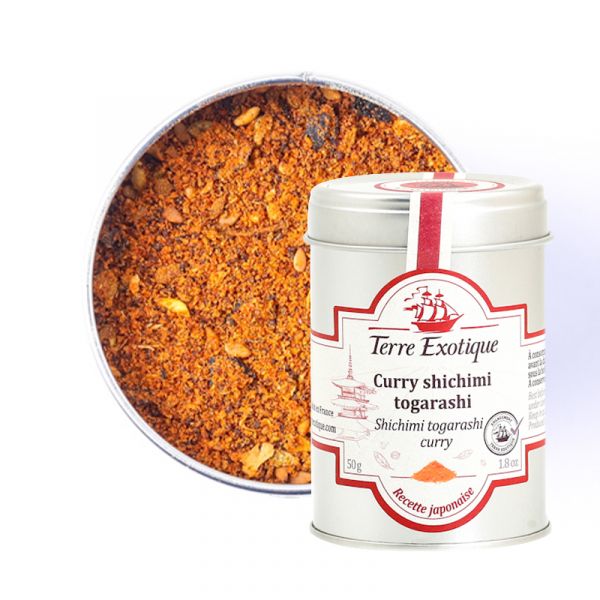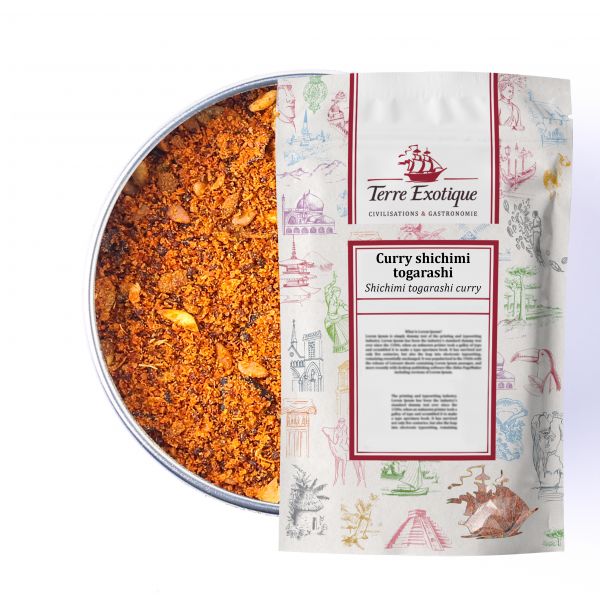



Where to use Shichimi togarashi?
Explore the flavours of Shichimi togarashi
This traditional Japanese 7-spice mix is made from: Cayenne chilli, poppy seeds, orange powder, sesame seeds, Batak berry, ginger and nori leaf. It is both very aromatic and very hot so use sparingly or only for palates that can cope with scorching flavours.How to get the best from your Shichimi togarashi?
Our recipe ideas for this Shichimi togarashi:• Japanese pork tenderloin: sprinkle 3 teaspoons of Japanese curry over your pork tenderloin (check out the complete recipe below);
• Japanese chicken skewers: season your chicken pieces with 2 teaspoons of shichimi togarashi;
• Japanese trout “en papillote”: sprinkle 1 tablespoon of shichimi togarashi over your trout fillets then wrap them up in parchment paper and cook in the oven;
• Japanese chicken curry: mix 1 tablespoon of Japanese curry with 1 carton of coconut milk, 1 carton of coconut cream and chicken stock then leave your 6 chicken breasts to simmer in a casserole dish for 2 and a half hours;
• Salmon with shichimi togarashi: sprinkle 1/2 teaspoon of Japanese curry over your salmon steak before cooking;
• Japanese vinaigrette: mix together 4 tablespoons of rice vinegar, 1 tablespoon of honey, 4 tablespoons of soya sauce, 1 tablespoon of sesame oil, ½ teaspoon of shichimi togarashi, and 2 finely chopped shallots.
Japanese pork tenderloin
Ingredients1 pork tenderloin;
2 tablespoons Hoisin sauce (or Teriyaki sauce);
1 Chinese cabbage;
2 tablespoons honey;
2 tablespoons water;
2 tablespoons lemon juice;
1 onion;
2 tablespoons Terre Exotique olive oil;
2 teaspoons Terre Exotique Shichimi Togarashi.
Method
Start by preparing your Chinese cabbage, wash and cut into four.
Place on a baking tray covered with baking parchment. Mix the lemon juice, honey, olive oil, water and two pinches of shichimi togarashi in a bowl.
Then pour this over the Chinese cabbage and cook in the oven for 25 minutes at 180°C. Meanwhile, fry the pork tenderloin in butter.
Cover in Hoisin sauce and shichimi togarashi and continue cooking for about 20 minutes until the meat is fully cooked yet still moist and tender. Once the pork tenderloin is cooked, cut into slices and serve with the Chinese cabbage and jasmine rice. Aromas
The Japanese aromas of shichimi togarashi
Terre Exotique’s Japanese curry releases well balanced hot lemony notes with fruity aromas with salty yet fresh flavours due to the nori seaweed. An explosive delight for your palate.What is this Shichimi togarashi made from?
The Cayenne chilli used in this mix is one of the world’s hottest chilli peppers. This Pili-pili red chilli is harvested in Uganda (the pearl of Africa). Its botanical name is Capsicum frutescens and it is part of the Solanaceae family. It also grows in Madagascar, Congo and Zanzibar. This chilli pepper scores 9/10 on the Scoville scale (volcanic). It releases very strong and sweet flavours. Oranges or Citrus sinensis from China date back more than 2200 years, and became extremely popular in Europe during the 15th century. As oranges were highly treasured by the King’s court and symbolized wealth, many orangeries were built in the Royal châteaux and namely Versailles. Oranges are part of the Rutaceae family and their sweet and slightly acidic aromas make them the second most popular fruit in France. Poppy seeds come from the Papaver somniferum, a pretty little plant whose flowers are similar to poppies. Papaver somniferum means “sleep bringing”. It was initially used by the Egyptians for its medicinal properties in the 19th century and later became a real drug known as opium. Sesame known as Sesasmum indicum is part of the Pedaliaceae family. This plant is widely grown in Africa and Asia for its seeds. Used raw, grilled or ground, sesame seeds are widely used in European, Asian or American cuisine. Sansho berries are harvested south of Kobe in the Wakayama prefecture on Honshu Island. The best time for harvesting them is July and August. The berries are picked before fully ripe and dried, then the hard berry is discarded and only the pericarp is kept. Sansho berries have a delightful spicy yet tangy taste. The rhizome of the ginger plant, like turmeric is part of the Zingiberaceae family. Its botanical name is Zingiber officinale. It is widely used in Asian cuisine and an essential ingredient of Shichimi togarashi. Nori leaves are widely used in Japanese cooking. This red seaweed turns black or green when dry. The seaweed is harvested, dried then grilled which gives it its distinctive taste. It is rich in iodine, minerals and fibres. It is also called yakinori and grows in Asia but also off the coast of Brittany.The history of Japanese curry
Japanese curry, traditionally called Shichimi Togarashi in Japan was invented in 1625. Not far from the Yagenbori canal in Edo, some herbalists and apothecaries were looking to invent a healthy blend of spices and seeds to season Japanese dishes and it was here that Shichimi Togarashi was created in Yagenbori Nakajima’s shop. At Terre Exotique, we used the original recipe as inspiration to create our very own Japanese curry, as a tribute to this 400 year old legendary spice mix.| Allergen | Sésame / Sesame |
|---|---|
| Native country | FRANCE |
| Ingredients | Cayenne chili pepper, poppy seed, SESAME seed, orange powder, |
| Batak berry, ginger, nori seaweed. | |
| TRACES EVENTUELLES D'ALLERGÈNES | céleri, sésame, moutarde, fruits à coques. |
 Français
Français 